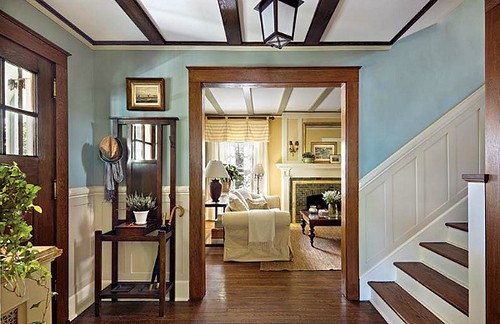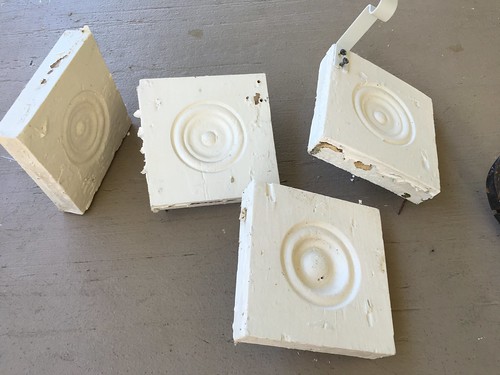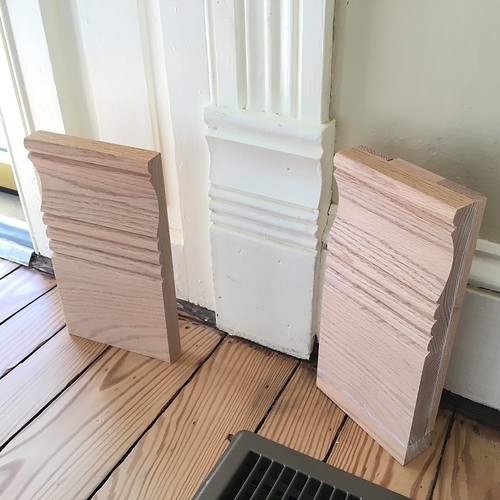Over the last several weeks I've been trying my best to replicate the historic moulding in our Foursquare.
This has been a difficult task overall as I've been dealing with several variables at once. Wonky walls, weird depth, modern doors, and chunkier wood than you find in stock moulding has made this somewhat more complicated than expected.
Our house is in rural Maryland and is technically a 1908 American Foursquare. At least, that's its style from the outside. But inside it's a house with a slight identity crisis. If you look up photos of American Foursquares from roughly this time you'll see a lot of interiors with dark wood, paneled walls, and flat mouldings that look more like this.

Photo Credit: Hooked on Houses
But in our home, it seems the exterior style was a little bit ahead of the interior. Our home retains most of its original mouldings, and I would certainly put them far more squarely in the late Victorian period than what is most commonly associated with early 20th century.
We have several different styles of ornate door and window casings...
...rosettes...

One of these things is not like the others...
...and plinth blocks that define the interior space of the house.
I have to say, I absolutely LOVE these plinth blocks. Is that weird?
Our house in Old Town doesn't have these ornate and classically Victorian detail, but oddly enough, these chunky blocks at the bottom of our doorways are one of the things I absolutely fell in love with when we first looked at our new house.
We actually have two different styles of plinth blocks in our house. One of the styles is larger than the other and is seen throughout the first floor and in the upstairs hallway.
The second style is smaller and is only in the second floor bedrooms.
However, as we've been renovating the living room I realized that the plinth blocks installed on the French door and front door were stolen from one of the upstairs rooms. Once I realized this I really wanted to install the right plinth blocks on these doors when we redid the moulding. The only problem, these big thick plinth blocks aren't the type of thing you typically see as stock moulding at the big box store, and a custom run of a few of these blocks would likely run a pretty steep $600 or more.
Though I felt a little discouraged I started looking around in moulding catalogs and wouldn't you know it, my favorite mill in California, Mad River Woodworks, had a plinth block that was almost identical to our original blocks. I gave Tim a call and placed an order. He already had several in stock in red oak so I ordered 14 of them for about $100.
When the plinth blocks arrived they were nearly a perfect match...nearly.
At first glance it looked pretty close, but when I placed the new one next to the old one I could see that the older ones are thicker, taller, and more narrow.
Rather than just accept the fact it would be different, I knew I could alter the new stock and make it look just like the old.
Ripping the new blocks to the right width would be easy on the table saw, but making them a little thicker and taller would be a little more tricky. I had some extra red oak 2x4 and trim pieces in our basement that I could splice in to make the changes I wanted.
In order to match up the height I had to add 1" to the bottom of the blocks. For the depth I'd need to add 1/2" to the back of the blocks. And since I needed to add both height and depth, I decided to do this by adding a 1" x 1-1/2" piece to the base of the blocks and a border of 1/2" stock to the upper back.
In each case I glued and nailed each piece to the plinth block and then filled all of the voids with wood filler. Finally, I sanded everything smooth. Once everything is primed and painted you'll never be able to tell it's made up of several different pieces.
Because of how these plinth blocks need to accommodate the wavy walls and other moulding, in some cases I had to get a little more creative. This was certainly one of the more difficult aspects of doing the moulding in this room.
When all was said and done my new plinth blocks looked almost exactly the same as the old plinth blocks. Here's a comparison of the old, original new, and the altered new blocks all hanging out together and partying.
Once this was installed it all looked good as old again.
I absolutely love that I was able to find a nearly matching profile to our originals in a moulding catalog. I also love that I was able to make the necessary alterations to make it match almost perfectly. There are few things in historic renovation that are quite as fulfilling as adding something to your home that looks like it's always been there.
Have you ever gone way out of your way to replicate historic moulding in your home? Do these details stick out to you the way they do to me, or is it something that you'd never notice unless someone were to point them out to you?

![]()
![]()